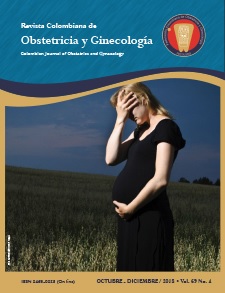The Colombian Journal of Obstetrics and Gynecology (Revista Colombiana de Obstetricia y Ginecología) and its value for the Colombian Federation of Obstetrics and Gynecology, FECOLSOG
DOI:
https://doi.org/10.18597/rcog.3285Abstract
One of the loftiest objectives of scientific societies is to promote science in the different fields of knowledge. The very first scientific society was the Royal Society of London, created in the United Kingdom in 1660, also known by the name of Royal Society of London for Improving Natural Knowledge. It was created as a “college for the promotion of experimental learning of physics and mathematics” and it published the first scientific journal in 1666 under the title of Philosophycal Transactions (1, 2), which remained the most important scientific publication until the emergence of specialized journals in the 19th century. At first, Philosophycal Transactions was home to news, letters and descriptions of experimental reports lacking standardized format or style (3). The first organization to publish a medical journal was the Edinburgh Medical School in 1731, with its Medical Essays and Observations, which became the Edinburgh Medical Journal two years later and was a peer-reviewed publication since 1733 (4). In the United States, the first medical journal was the Medical Repository, published for the first time in 1797 (5). In the United Kingdom, The Lancet appeared in 1823 containing the work developed in the London medical schools as well as case reports, followed by the British Medical Journal in 1853, as a result of the newly created British Medical Association (4). In 1887, Philosophycal Transactions was split into two new publications: one journal focused on mathematics and physics, and the second devoted to biology. In 1989, an important innovation came on stage: anonymous peer review of the content. All of the above is a reminder of the fact that medical journals originated from within scientific societies and medical schools with the aim of describing the methodologies as well as the results of their research and have been characterized from the very beginning by a rigorous anonymous peer review process.Author Biographies
Hernando Gaitán-Duarte
Editor
Jorge Andrés Rubio-Romero
Departamento de Obstetricia y Ginecología
Universidad Nacional de Colombia
Editor Asociado
Carlos Fernando Grillo-Ardila
Departamento de Obstetricia y Ginecología
Universidad Nacional de Colombia
Editor Asociado
References
Hunter M. Royal Society. Enciclopedia Británica. Disponible en: https://www.britannica.com/topic/Royal-Society.
Marta MM. A brief history of the evolution of the medical research article. Clujul Med. 2015;88:567-70. https://doi.org/10.15386/cjmed-560
Hyland K. Academic Discourse: English in a Global Context. London: Continuum; 2009.
Booth CC. Medical communication: the old and the new. BMJ. 1982;285:105-8. [PMC free article] [PubMed]. https://doi.org/10.1136/bmj.285.6335.105
Kahn RJ, Kahn PG. The Medical Repository — The First U.S. Medical Journal (1797-1824). N Engl J Med. 1997;337:1926-30. https://doi.org/10.1056/NEJM199712253372617
Royal College of Obstetricians and Gynecologist. RCOG strategy. Disponible en: https://www.rcog.org.uk/en/about-us/what-we-do/rcog-strategy/
The American College of Obstetricians and Gynecologists. ACORE Mission, Vision and Core Values. Disponible en: https://www.acog.org/About-ACOG/About-Us/ACOG-Mission-Vision-and-Core-Values
Silva-Mojica CR. Misión de nuestra sociedad. Rev Colomb Obstet Ginecol. 1953;4(3):85-6
FECOLSOG. Historia. Disponible en: https://www.fecolsog.org/historia/
FECOLSOG. Política de calidad. Disponible en https://www.fecolsog.org/politica-de-calidad/
Guía de práctica clínica para la detección temprana de las anomalías durante el trabajo de parto, atención del parto normal y distócico. Rev Colomb Obstet Ginecol. 2013;66(4):379-424.
Guía de práctica clínica para el manejo sindrómico de los pacientes con infecciones de transmisión sexual y otras infecciones del tracto genital – 2013. Rev Colomb Obstet Ginecol. 2013;64:126-77.
Racionalización del uso de la cesárea en Colombia. Consenso de la Federación Colombiana de Obstetricia y Ginecología (Fecolsog) y la Federación Colombiana de Perinatología (Fecopen). Bogotá, 2014. Rev Colomb Obstet Ginecol. 2014;65:139-151. https://doi.org/10.18597/rcog.62
Vélez-Álvarez GA, Agudelo-Jaramillo B, Gómez-Dávila JG, Zuleta-Tobón JJ. Código rojo: guía para el manejo de la hemorragia obstétrica. Rev Colomb Obstet Ginecol. 2009;60:34-48.
Guía de práctica clínica para la prevención de eventos tromboembólicos venosos durante la gestación, el parto o el puerperio. Rev Colomb Obstet Ginecol. 2017;68:285-304.
Gómez Palacino JA. La Revista Colombiana de Obstetricia y Ginecología, un patrimonio intransferible. Rev Colomb Obstet Ginecol. 2004;55:103-6. Disponible en: http://www.scielo.org.co/scielo.php?script=sci_arttext&pid=S0034-74342004000200001&lng=en.
León JW. Situación actual de la Revista Colombiana de Obstetricia y Ginecología. Rev Colomb Obstet Ginecol. 2005 [visitado 2018 dic 16];56(1):9-10. Disponible en: http://www.scielo.org.co/scielo.php?script=sci_arttext&pid=S0034-74342005000100001&lng=e
How to Cite
Downloads
Downloads
Published
Issue
Section
| Article metrics | |
|---|---|
| Abstract views | |
| Galley vies | |
| PDF Views | |
| HTML views | |
| Other views | |
















